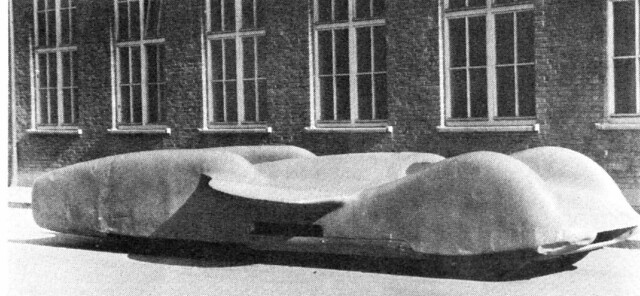There's an earlier thread on the car, although sadly the photos posted are no longer available:
Something truly exotic...and there are mentions in other threads, including this one:
Record Attempts with Gasoline Powered Cars.which features a fine potted history from Michael Müller:
Some more information about this project. Hans Stuck in 1936 had the idea to break Campbell's land speed record in. He was still one of the top drivers of Auto-Union, but his position was endangered by young Bernd Rosemeyer, so he was in need of some publicity. He had good personal contacts to Professor Porsche, not only by their mutual work for AU, but Stuck was also investor when Porsche founded his own construction office at Stuttgart. Porsche was so enthusiastic about this idea that he offered to work on the project free of charge.
The main problem was the engine power, Campbell's Bluebird used a 2500 HP RR aero engine, and for reaching 500 km/h Porsche calculated 3000 HP to be necessary. Strongest engine available was Mercedes-Benz' DB 600 with 1000 HP resp. DB 601 (fuel injected) at 1300 HP. However, these engines had been available as prototypes only, ordered by Ministry of Aviation. Director of its procurement department was Ernst Udet, flying ace in WW1, and a close friend of Hans Stuck, and so it was rather easy to get Udet's agreement to receive 2 of these engines.
Next step was to find somebody to build the car, as Porsche was only able to do the theoretical work. Auto-Union was not interested, the project was too expensive, and they had enough to do with their GP cars. So Stuck went to his old friends at Mercedes-Benz. Director Kissel was not pleased that Porsche was involved in the project, because there was still some kind of rivalry between them dating back to Porsche's MB period. On the other side he was afraid that if MB is not doing the job, Stuck will take the 2 engines,which legally had been owned by Ministry of Aviation, to get the car build by one of their competitors. And of course this was not in the interest of Mercedes-Benz! So they finally agreed, under the condition that Stuck will find finance for the project. Based on Porsche's system of running project numbers, the car was the type 80, or T80. Expected delivery date was end of 1937.
Porsche started the construction, and also DB made some progress in engine development. The latest version of DB 601 was able to reach 2000 HP, and so Porsche proposed change of the concept, using only one engine instead of 2, saving considerable weight. Theoretical calculations gave a speed of 550 km/h after 5 kms, based on 2200 HP, or better 2500 HP. In November 1937 the team was shocked by the news that George Eyston with his "Thunderbolt" set the new mark at 502.1 km/h, claiming to have sufficient reserves for further increases. This delayed the project, because there was no way to achieve the now necessary higher engine power, and also the work on the new GP car, the W 154, set preferences. Late summer 1938, just when final assembly of the car started, the latest news came in: Eyston reached 556.0 km/h, increased by John Cobb with his "Railton Mobil Special" to to 563.5, only to be topped again by Eyston with 575.3 km/h!
Porsche had to revise the whole construction by setting the new target to 600 km/h, for which he calculated 3000 HP to be necessary. The new DB 603 aero engine was under development, and engineers believed they can reach this level. Work on the T80 chassis went on, and early 1939 an DB 603 engine was installed for the first time. It would go too far to describe all the technical details, but remarkably is that the T80 had 3 axles, with power transmission to the 2 rear ones. Also interesting is that the T80 most likely was the first car using reversed airkraft wings for achieving ground effect, a thing today we call "spoiler". Including bodywork, but without driver and fuel the car weighted 3024 kgs.
Problem was still the engine. The DB 603 in its strongest development version still had only 2800 HP, and as Cobb increased the record on August 22 to 595 km/h, this was considered not being sufficient. In october the car was tested on the Rennabteilung's testing bench, and all details which needed fixing and changing would need another month or so. However, due to the war the project was stopped, and later even mothballed. There had been intentions to continue after the war, but when John Cobb in 1947 set the mark to 634.4 km/h, they finally gave up.















